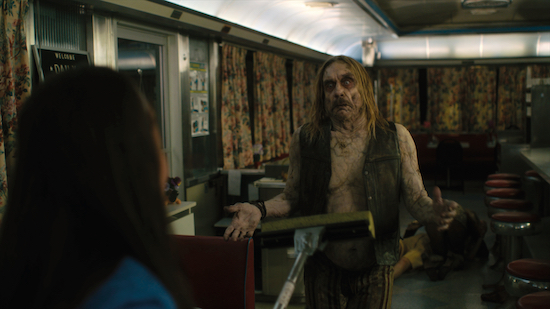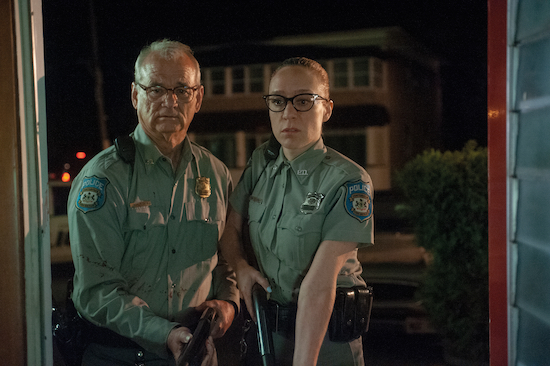Jim Jarmusch’s THE DEAD DON’T DIE, a Focus Features release. Credit : Abbot Genser / Focus Features © 2019 Image Eleven Productions, Inc.
The poster for Jim Jarmusch’s 13th film, The Dead Don’t Die, with its wonderfully lurid central image of a blood-red undead Iggy Pop set against an unnaturally purple-tinged moon, and Bill Murray, Adam Driver, Chloë Sevigny and Tilda Swinton illumined in silvery light from that same satellite, holds an enormous amount of promise. Critics appear divided as to whether it delivers. Jarmusch’s modus operandi of long pauses, slow and deadpan dialogue has become a genre unto itself, but even committed fans may find some of his work problematic. Many found his previous entry into the horror genre, the vampire-themed Only Lovers Left Alive, to be difficult to swallow, whereas personally, I found his portrayal of the mundanity of every day life in Paterson to be the point at which I questioned whether Jarmusch still ‘had it’ or not. The Dead Don’t Die, I’m happy to say, is Jarmusch’s best film in years, and also his most overtly political.
A point repeatedly made in less favourable reviews of the film is that this is a well-worn genre, and Jarmusch’s additions of the fourth wall transgressing perceptions of Adam Driver’s character or the admittedly unsubtle targets for satire such as Steve Buscemi’s racist farmer, do little to distinguish it from other similar entries. This is a misperception on several fronts. First of all, this is very much a Jarmusch film, populated by his usual cast of laconic, deadpan characters and could hardly have been made by anyone else. Secondly, the meta-perceptions of officer Ronnie Peterson, who keeps repeating “This isn’t going to end well”, are used to pointed effect, calling into question our own reactions to a script we know isn’t going to have a pleasant ending, and asking us to consider what we ourselves might be doing to avert the catastrophe we can all see – very obviously – approaching from not too far off.
Jarmusch’s concern for humanity’s adverse effect on the environment was already apparent in Only Lovers Left Alive, where the characters of Adam and Eve express their concerns for what the ‘zombies’ (their way of referring to us mortal humans) are doing to themselves and their planet. Tilda Swinton’s Eve, addresses some unseasonal fly agarics at one point, saying: “you guys shouldn’t really be here”. Tom Waits’ character in The Dead Don’t Die, Hermit Bob, does exactly the same thing. We learn that the Earth’s axis has been altered by “polar fracking”, whilst industrialists and their paid political lackeys can be overheard on radio stations denouncing claims of their accountability. “Let’s not believe something if one scientist tells us it’s true”, one voice suggests. Although there are innumerable entries in the prolific zombie genre, it is very difficult to find films that deal with humanity’s denial of climate change in such a direct way as this. Only Paul Schrader’s excellent 2018 film First Reformed springs to mind.
If there is much that is absurd in Jarmusch’s film, little of it can match the absurdity of knowing we have cast ourselves as the agents of our own destruction, yet remain utterly without the ability to transcend our persistent denial of the situation. Deceptively simple on the surface, The Dead Don’t Die finds subtle ways of portraying this state of affairs. The film’s title song, ‘The Dead Don’t Die’, by Sturgill Simpson, features repeatedly on the radio. Selena Gomez’s character, Zoe, says “I love this song”, yet fails to recognise the portent of doom its lyrics offer: “Oh, the dead don’t die/Any more than you or I/They’re just ghosts inside a dream/Of a life that we don’t own/They walk around sometimes/Never payin’ any mind/To the silly lives we lead/Or the reaping we’ve all sown”.

Jim Jarmusch’s THE DEAD DON’T DIE, a Focus Features release. Credit : Abbot Genser / Focus Features © 2019 Image Eleven Productions, Inc.
Tom Waits’ misanthropic Hermit Bob, is a kind of anti-hero of the piece, observing events at a distance and quoting Herman Melville: “[every one knows that this earthly air, whether ashore or afloat, is terribly infected with] the nameless miseries of the numberless mortals [who have died exhaling it]’. Indeed, it’s only the marginal characters, such as Bob, or the three young people of colour held in a children’s detention centre, who get what’s really happening from the onset. The other characters ask if perhaps the first killings were caused by: “a wild animal or maybe a group of wild animals?” It’s a lame gag that falls flat each time it’s used, but that’s clearly intentional.
RZA has an amusing, brief cameo as a ‘Wu-PS’ delivery driver in which he offers the Zen-like nugget: “The world is perfect, appreciate the details”. Steve Buscemi’s farmer Frank Miller, sports a hat that proclaims the grammatically and factually incorrect travesty ‘Keep America White Again’, and keeps a guard dog called ‘Rumsfeld’.
For some, such satire may be too direct, or its targets too obvious. This was a also a criticism from certain quarters of a number of episodes from the Jordan Peele-fronted new series of The Twilight Zone that I felt to be unjust. Whilst the bluntness of the message displayed on farmer Frank’s hat might be momentarily shocking to the viewer, it’s hardly as shocking as the fact that such satire is more necessary than ever given the current state of American politics.
Only Chloë Sevigny’s character is somewhat disappointing, sticking too close to the horror genre stereotype of vulnerable female. It is perhaps understandable that some of that trope might feature in a genre movie, but Jarmusch could have written her differently, without having to change any plot elements.
Overall though, this is a real return to form for Jarmusch – a far more political movie than he’s ever made, which sacrifices nothing of the warmth and gentle humour for which he is more usually known. Even the ending’s use of a quite ridiculous anti-ex machina device, fits well within his purpose, once you consider it.
Jarmusch’s method might be absurdist in nature, but the question he leaves in the audience’s mind is a very real one that we might do well to answer soon. Are we collectively going to ‘get out of the car’ and face the ‘zombie horde’ or are we just going to stay sitting there doing nothing?
The Dead Don’t Die is at UK cinemas now


